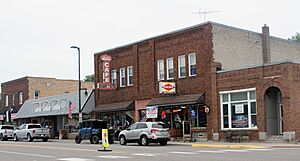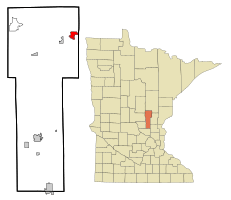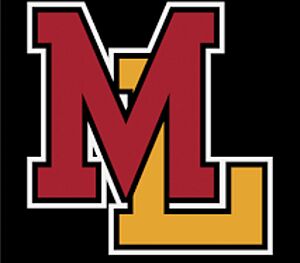Isle, Minnesota facts for kids
Quick facts for kids
Isle, Minnesota
Chi-minising
|
|
|---|---|

Businesses in Isle
|
|
| Nickname(s):
"The Little City on the Big Lake"
|
|

Location in Mille Lacs County and the state of Minnesota
|
|
| Country | United States |
| State | Minnesota |
| County | Mille Lacs |
| Area | |
| • Total | 3.13 sq mi (8.12 km2) |
| • Land | 2.70 sq mi (6.99 km2) |
| • Water | 0.44 sq mi (1.13 km2) |
| Elevation | 1,276 ft (389 m) |
| Population
(2020)
|
|
| • Total | 803 |
| • Density | 297.63/sq mi (114.91/km2) |
| Time zone | UTC-6 (Central (CST)) |
| • Summer (DST) | UTC-5 (CDT) |
| ZIP code |
56342
|
| Area code(s) | 320 |
| FIPS code | 27-31472 |
| GNIS feature ID | 0645530 |
Isle is a small city located in Mille Lacs County, Minnesota, United States. It's known for being near the large and beautiful Mille Lacs Lake. In 2020, about 803 people lived here, which was a bit more than the 751 people counted in 2010.
Contents
History of Isle
Isle has had a post office since 1896. The city got its name from an island. This island is located close to the city's harbor on Mille Lacs Lake.
Geography and Location
Isle is in the northeastern part of Mille Lacs County. It sits right along Isle Harbor, which is at the southeastern edge of Mille Lacs Lake.
Main Roads
Two important roads, Minnesota Highway 27 and Minnesota Highway 47, pass through Isle.
- Highway 27 goes southwest about 3 miles (5 km) to Wahkon. It then continues about 12 miles (19 km) to Onamia.
- Highway 47 heads north about 15 miles (24 km) along the east shore of Mille Lacs Lake to Malmo.
- Together, these two highways leave Isle to the southeast. Highway 27 goes east about 10 miles (16 km) to Woodland. Highway 47 goes south about 22 miles (35 km) to Ogilvie.
Land and Water
The city of Isle covers an area of about 3.13 square miles (8.12 square kilometers). Most of this area, about 2.70 square miles (6.99 square kilometers), is land. The rest, about 0.44 square miles (1.13 square kilometers), is water. This water includes part of Isle Harbor in Mille Lacs Lake. It also includes Anderson Lake in the northeast. Water from Mille Lacs Lake flows into the Rum River. The Rum River then joins the mighty Mississippi River.
"Walleye Capital"
Isle is often called the "walleye capital of the world." This is because of its great location on Mille Lacs Lake, which is famous for its walleye fishing.
Schools in Isle
Isle has its own school district called Isle Public Schools. The school sports teams are known as the Mille Lacs Raiders. They used to be called the Isle Huskies.
There are three main schools in this district:
- Nyquist Elementary: This school teaches students from pre-kindergarten up to sixth grade.
- Isle High School: This school is for older students, from 7th to 12th grades.
- Alternative Learning Center (ALC): This is another option for secondary school students. It is located close to Mille Lacs Lake.
Population Information
| Historical population | |||
|---|---|---|---|
| Census | Pop. | %± | |
| 1920 | 328 | — | |
| 1930 | 523 | 59.5% | |
| 1940 | 567 | 8.4% | |
| 1950 | 674 | 18.9% | |
| 1960 | 529 | −21.5% | |
| 1970 | 551 | 4.2% | |
| 1980 | 573 | 4.0% | |
| 1990 | 566 | −1.2% | |
| 2000 | 707 | 24.9% | |
| 2010 | 751 | 6.2% | |
| 2020 | 803 | 6.9% | |
| U.S. Decennial Census | |||
2010 Census Details
In 2010, the city of Isle had 751 people living there. There were 352 households, which are groups of people living together. Out of these, 195 were families. The city had about 354 people per square mile (137 people per square kilometer). There were also 501 housing units, like houses or apartments.
Most of the people in Isle were White (73.8%). About 22.6% were Native American. A small number were Asian (0.1%) or from other races (0.8%). About 2.7% of the people were from two or more races. People who identified as Hispanic or Latino made up 3.1% of the population.
The average age of people in Isle was 47.5 years old. About 23.4% of residents were under 18 years old. About 28.2% were 65 years old or older.
Gallery
See also
 In Spanish: Isle (Minnesota) para niños
In Spanish: Isle (Minnesota) para niños








